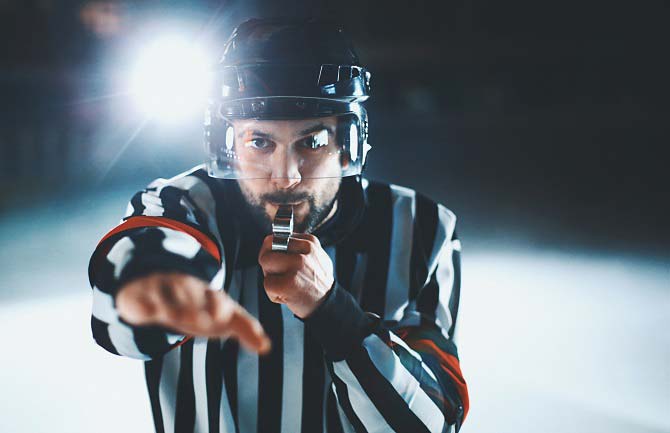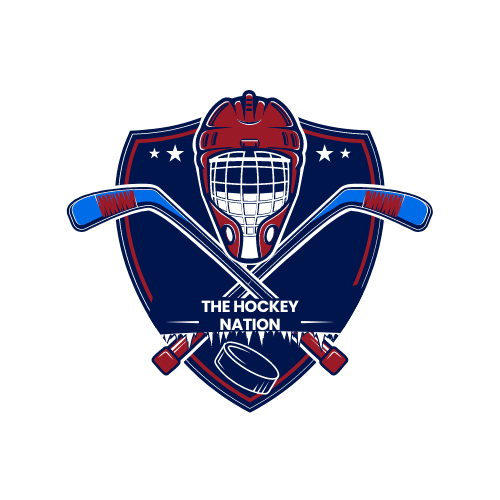You never want to hear those two words – “match penalty” – in a hockey game, right? Hockey can get pretty intense with guys zooming around, trying to knock each other over just to grab the puck.
And with all that action, you’ve got collisions happening all the time. Most are fair, but some are a bit sketchy. When things get really dicey, that’s when the match penalty steps in.
The Hockey Nation breaks down what a match penalty means in the NHL.
What is a match penalty in hockey?

In hockey, a match penalty means trouble! It’s a five-minute major penalty for the player in question, plus they’re out of the game immediately.
Here is how Rule 21.1 reads in the NHL rulebook:
A match penalty means a player gets sidelined for the rest of the game, heading straight to the dressing room. It’s the consequence for any player who intentionally tries to harm or injures an opponent.
Any match penalty is required to be reviewed by the on-ice officials for the purposes of either confirming or modifying the call.
Match penalty vs. major penalty

The key distinction between a match penalty and a major penalty in the NHL lies in the concept of “intent to injure” attached to the match penalty rule.
In both instances, the player at fault is handed a five-minute major penalty. However, if the refs perceive that the actions were carried out with the deliberate aim of harming the opponent, that’s when the match penalty is invoked.
When a skater incurs a major penalty, there could be a game misconduct associated with it, resulting in the player’s ejection from the game. But once again, it’s at the discretion of the officials to decide whether a game misconduct should accompany the major penalty.
Different hockey rules for different leagues
Most fans are familiar with hockey rules in the context of the National Hockey League, the pro league in North America. However, different leagues and age groups have their own variations.
Each league, be it the NHL, college, junior, or youth hockey, has its unique set of rules. There are also differences between leagues in the US, Canada, and worldwide. Safety is a top priority, guiding the rules and penalties.
For instance, youth hockey abides by USA Hockey rules, though local leagues can tweak rules to fit their needs as long as safety isn’t compromised.
Minor penalties in hockey
In a hockey game, most penalties called are minor ones, leading to a two-minute stint in the penalty box. This puts the penalized team at a disadvantage, while the opposing team enjoys a “power play” with an extra player.
If the power play team scores, the penalty time resets, and the player returns, restoring balance. Occasionally, officials may impose double or triple minors, extending time in the box. Despite numerous minor penalties, some are common occurrences, adding to the game’s excitement.
The most common minors include:
- High sticking is when you make contact above the shoulder with your stick, whether on purpose or by accident. If it leads to an injury, the penalty can get bumped up.
- Holding is when you grab a player’s body, sweater, or stick, or block them from reaching the puck.
- Hooking happens when you use the blade of your stick to hold back an opponent and stop them from moving.
- Cross-checking is when you hit an opponent using your stick with both hands to check them.
- Roughing is when you strike an opponent during a scuffle that the refs don’t see as too serious for a harsher penalty. Sometimes, if a player throws punches with gloves on during a fight, they might get a roughing penalty.
- Tripping is causing an opponent to fall by using your stick or body to trip them up.
Major hockey penalties
A major hockey penalty can be handed out for similar offenses as in the minor leagues, but it’s considered a more serious punishment by the officials. When a major penalty is given, the team plays short-handed for five minutes in the penalty box.
Unlike other penalties, a major penalty isn’t cut short if the power play team scores. Interestingly, in a fight scenario where both players get fighting majors and head to the box, substitute players can jump in, and both teams resume at full strength.
Some typical infractions that earn players a major hockey penalty include:
- Boarding — It’s like a high-speed dance against the boards, checking, tripping, or giving a nudge to the side or end boards.
- Spearing — Picture a stick wielding warrior striking with the blade in a stabbing motion.
- Slashing — A stealthy, swift stick strike; a chop to the lower body that leaves a mark.
- Charging — Like a thunderous force, a player takes strides to gain momentum, ready to unleash on an opponent.
- Check from behind — A surprise attack from the rear, catching the opponent off guard, no chance to brace.
- Check to the head — Any contact above the shoulders, putting the head in the danger zone.
- Fighting — The ultimate showdown, where gloves drop, and fists fly in a raw display of force.
Misconduct penalties in hockey

When a player gets a misconduct penalty, they sit in the penalty box for 10 minutes. But hey, the team swaps them out, so it’s all good on the ice!
Misconduct penalties usually come with another penalty, like a fighting major, to give players a breather. Actions like fighting off the ice, throwing gear, or getting mouthy with officials can land you in the box!
Game misconduct penalties
A player assessed a game misconduct penalty is ejected from the contest and sent to the dressing room. Game misconducts are often assessed along with another penalty, such as a five-minute major.
The game misconduct is added in the official’s judgement following a severe infraction. For example, when a player is assessed a major for boarding an opposing player, but that player suffers an injury, the infraction can be upgraded to a game misconduct resulting in an ejection.
The penalty goes into the books as a 10-minute penalty, but the team can immediately substitute another player and the teams remain at even strength. However, if the game misconduct is paired with a five-minute major, another player from the team will be sent to the box to serve the five minutes.
A player who earns three game misconducts in a season in the NHL, or two such hockey penalties for stick infractions, boarding, or checking from behind, automatically gets a one-match ban. This disciplinary action is put in place to enforce player conduct and maintain the integrity of the game.
In addition to a penalty that results in an injury, other examples of hockey penalties that can earn a game misconduct include leaving the penalty box before the penalty is up, striking a spectator, leaving the penalty box during an on-ice fight, using racial slurs, attempting to injure nonplayer personnel like a coach, or returning to the ice after being ordered to the dressing room. These strict rules aim to uphold sportsmanship and safety in professional hockey leagues.
Hockey match penalties
A match penalty in hockey results in a player being ejected from the game. It leads to a 10-minute penalty, during which the player is removed from the ice. The team plays shorthanded for five minutes. This penalty is given for intentional harm or dangerous plays, such as stick offenses or checks to the head.
Conclusion
Hockey, with its fast-paced and intense nature, demands not only physical prowess but also adherence to a set of rules designed to maintain fairness and ensure the safety of all participants.
Penalties, ranging from minor to match, serve as a deterrence against unsportsmanlike conduct and dangerous play, highlighting the importance of discipline and respect among players.
While these penalties can momentarily shift the dynamics of the game, giving one team a temporary advantage, they fundamentally aim to uphold the integrity and spirit of the sport.
The enforcement of these rules through various penalties ensures that hockey remains a thrilling yet safe sport for players and a spectacular display of skill and sportsmanship for fans worldwide.
